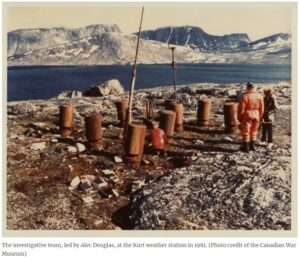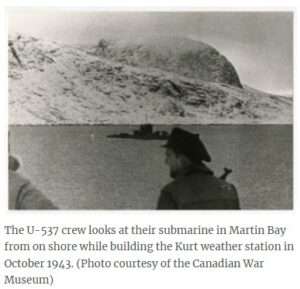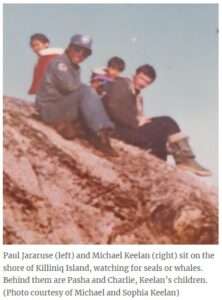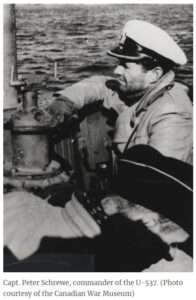![]()
Congratulations to Cedric Gallant of the Nunatsiaq News, who won second prize in the Best Feature Article Awards in the 2024 Quebec Community Newspaper Awards competition. (The Townships Sun came in first with Marie Moliner’s “Megantic, Then and Now.”)
Gallant’s winning article was “Who really discovered this remote Nazi weather station on the northern tip of Labrador?” It turns out that locals knew best!
Published since 1973, Nunatsiaq News is a weekly newspaper serving Nunavut and the Nunavik territory of Quebec.
Read their winning feature here:
Who really discovered this remote Nazi weather station on the northern tip of Labrador?
No one knows for sure why Kurt weather station stopped transmitting weeks after it was built, but area was a popular Inuit fishing spot.

![]()
In October 1943, a Nazi U-boat approached the northern tip of Labrador under the dark of night to set up a weather station.
 The site, with a radio transmitter, batteries and several canisters hastily camouflaged to look like Canadian equipment, was the only Nazi-made structure to have been raised on North American soil.
The site, with a radio transmitter, batteries and several canisters hastily camouflaged to look like Canadian equipment, was the only Nazi-made structure to have been raised on North American soil.
Nestled on the shore of Martin Bay just south of Killiniq Island, it sat for about 40 years before Alec Douglas, a Canadian Armed Forces historian, made the trip to find and make official documentation of its existence.
From a southern perspective, Douglas discovered the Kurt weather station in the summer of 1981.
However, a former resident of Killiniq Island says the area was a popular Inuit fishing spot for generations.
Douglas wrote about his trip for the December 1981/January 1982 issue of Canadian Geographic.
“Someone had been there before us,” he wrote. “Every canister had been opened. Batteries and radio parts seem to have been systematically dismantled […] the equipment had been deliberately smashed.”
The people who had been there before did leave some evidence behind.
“Nearby, we saw a circle of stone suggesting a camp,” Douglas wrote. “Underneath one canister was a clue: a single .303 rifle cartridge bearing the inscription ‘British Dominion.’”
The Kurt weather station was only operational for a few weeks before it stopped transmitting data under mysterious circumstances.
Douglas considered Inuit may have happened upon the site but brushed aside that theory because cables had been cut cleanly, suggesting whoever did it used tools not normally carried by hunters.
He also considered the U.S. Navy and Canadian military as suspects.
“There are many questions left unanswered,” wrote Douglas. “They may never be.”
Four years before Douglas’s trip, in August 1977, a then 24-year-old Michael Keelan was fishing with his brother-in-law, Paul Jararuse. They navigated to a spot near Martin Bay, called Taliarusik Inlet in Inuktitut.
“We were char fishing on the shore, and after we were done we started wandering around,” Keelan said in a phone interview with Nunatsiaq News.
“I then saw a bunch of papers and batteries laying on the ground. When I went to look at them, there were strange writings on them.”
Keelan said he asked about it when he got back.
“Some of the older elders said, ‘Oh yeah, there was some kind of a weather station there that wasn’t American,’” he said.
 Keelan recognized the .303 rifle cartridge mentioned in the Canadian Geographic essay. Most hunters were using Ranger-supplied British Enfield rifles, which used these cartridges.
Keelan recognized the .303 rifle cartridge mentioned in the Canadian Geographic essay. Most hunters were using Ranger-supplied British Enfield rifles, which used these cartridges.
The stone circle camp remnants were familiar, too — Inuit traditionally used stones for the base of their tents, arranged in a circular shape.
So, were the Inuit who lived on Killiniq Island the quiet Second World War allies who destroyed the station? Keelan says he doesn’t know.
By the time Douglas made it to Martin Bay, no one lived in the area anymore. The Northwest Territories government forcibly removed the Inuit from Killiniq Island in 1978.
In an interview, the Canadian War Museum’s Second World War historian Jeff Noakes explains the German history behind the Kurt weather station.
He said German commander Capt. Peter Schrewe departed Europe in late September 1943, in U-537, a U-boat submarine.
Being in water patrolled by the Allies, the crew had to travel in the dark with no radio transmissions and spend as little time on the surface as possible.
 South of Greenland, the U-boat encountered a heavy storm and the seas washed away one of its gun mountings.
South of Greenland, the U-boat encountered a heavy storm and the seas washed away one of its gun mountings.
Close to a month later, Schrewe reached the Labrador Coast and anchored on the south shore of Martin Bay.
Noakes says the weather station was built to give Nazis help in weather forecasting.
“The Germans tried to figure out what the weather would be over the North Atlantic, because weather patterns generally move from west to east,” he says.
By knowing what weather conditions were like near Canada, the Germans could predict the weather that would be coming at them in a few days’ time.
He says when the Germans were looking for a place to install their weather station, “they wanted an area that they believed would not have a particularly high population.”
Little did they know, the place they stumbled upon just happened to be a great place for fishing.
Get the article here:
Who Really Discovered this Remote Weather Station on the Northern Tip of Labrador

